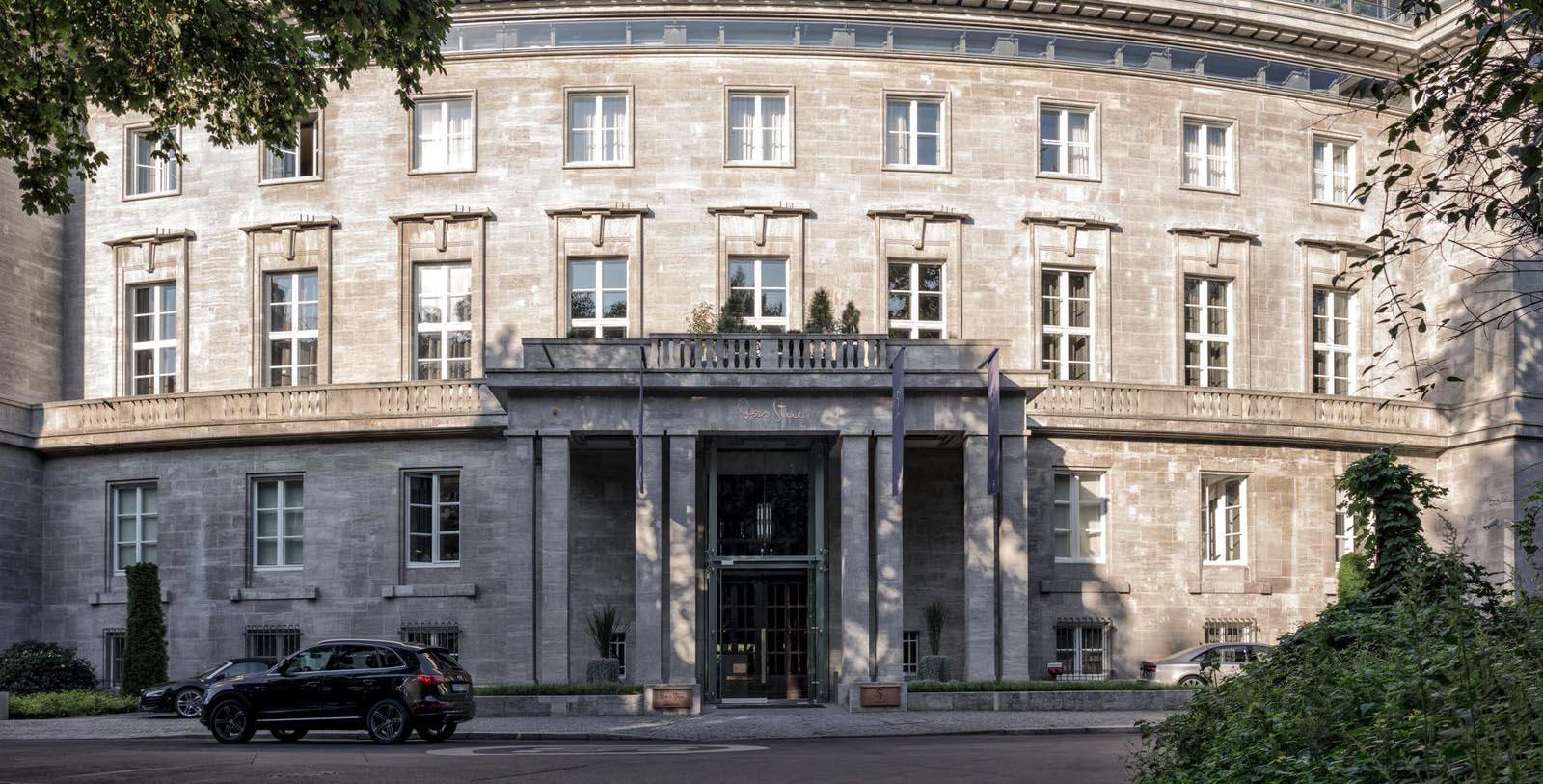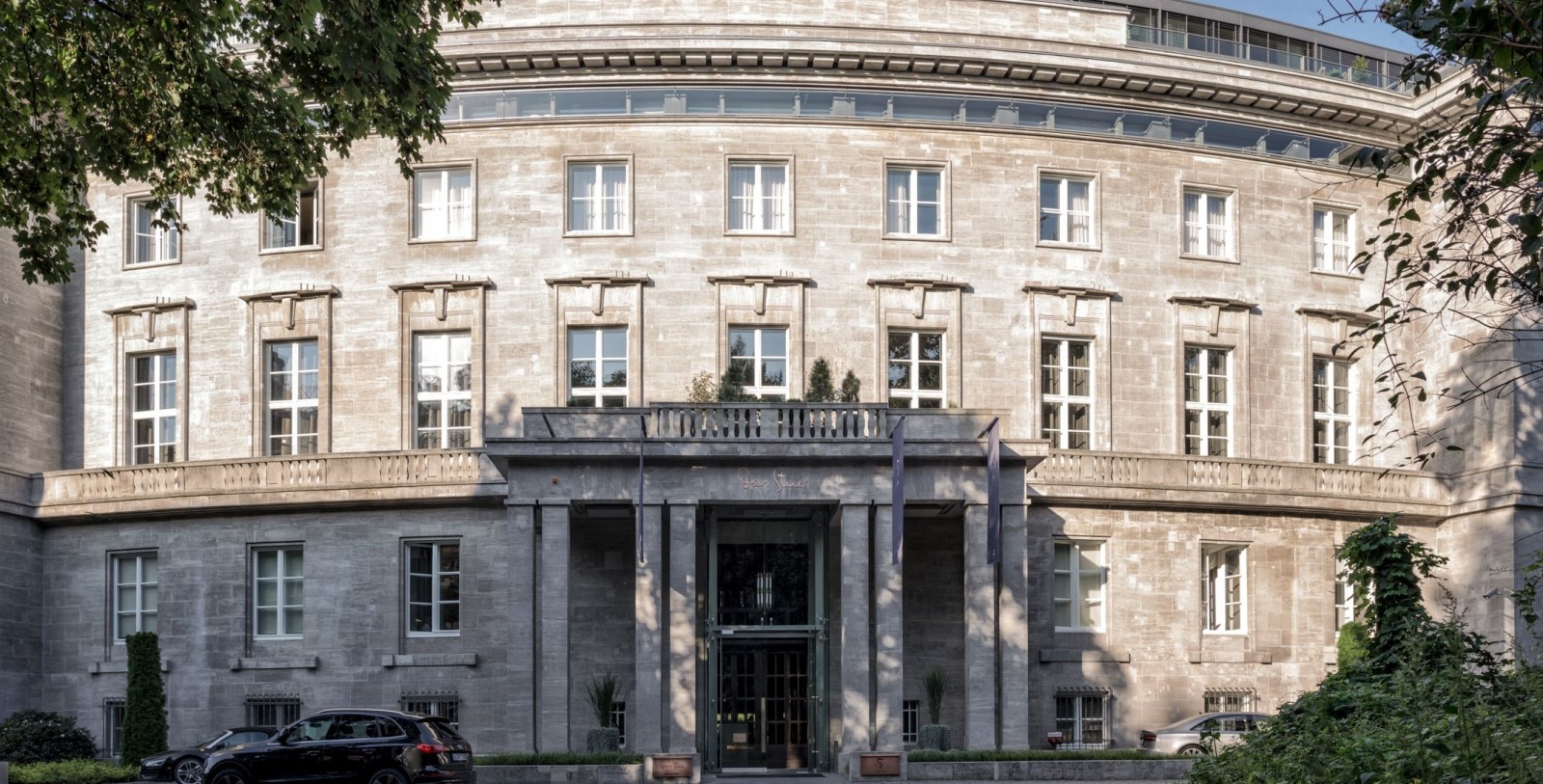Receive for Free - Discover & Explore eNewsletter monthly with advance notice of special offers, packages, and insider savings from 10% - 30% off Best Available Rates at selected hotels.
history
Discover the SO/ Berlin Das Stue, which was once the Royal Danish Embassy in Berlin.
A member of Historic Hotels Worldwide since 2018, the building that now constitutes the SO/ Berlin Das Stue has overlooked downtown Berlin for close to a century. The story of the SO/ Berlin Das Stue dates to 1938, when Denmark created a new embassy in Berlin’s bustling Embassy Quarter. Architect Johann Emil Schaudt oversaw its construction, relying upon Neoclassical architecture for his inspiration. Schaudt designed the future Das Stue in a style reminiscent of German department stores, incorporating a curving front façade that was tiered with cascading balconies. It took Schaudt two years to build Das Stue, who then turned it over to the Danish government in 1940. Denmark reclaimed the building after World War II, finding that it had been damaged toward the beginning of the conflict. The Danish government subsequently overhauled the structure in 1947, using the site as a consulate once more. The building served as the Royal Danish Embassy for the next 38 years, until the Danes sold it for public housing during the late 1970s. The company that acquired the building, though, let it to fall into disrepair. Fortunately, city officials saved the site in 1983, transforming it into a vast office complex. Three years later, the Deutsche Bundespost (the German Post Office) and Deutsche Telekom began using the location as a venue for executive training. Das Stue finally became a hotel in 2009, undergoing a massive renovation spearheaded by Axthlem Architects, an architectural firm based in Potsdam. The firm added a modern, trapezoidal wing onto Das Stue, which connects directly onto its original structure. Axthlem Architects integrated sharp angles throughout the modern wing, which provided the space with contemporary living accommodations and beautiful views of the nearby Tiergarten. In the building’s historical portion, the firm diligently preserved its traditional detailing as much as possible SO/ Hotels and Resorts—a subsidiary of AccorHotels—now manages this marvelous historic hotel as the luxurious “SO/ Berlin Das Stue.”
-
About the Location +
Berlin itself is an ancient city defined by years of history. While no exact date exists to chronicle the founding of the municipality, most experts agree that it first emerged at the height of the Middle Ages. The earliest known historical records that speak of Berlin harken back to the 11th century, in which they talk of two small communities situated along the banks of the Spree. Called “Berlin” and “Cölln,” respectively, the settlements were primarily populated by hunters, fisherman, and other outdoorsmen. Over time, though, merchants settled the area, causing the two communities to build tight economic and social ties. By the beginning of the following century, the settlements had formed an incredibly close partnership, although they both retained a certain amount of autonomy in regard to their daily administration. The two polities would not completely form one single entity until the beginning of the 1400s, when the mighty Hohenzollern family established them each as the dual capital for the “Margraviate of Brandenburg.” A noble family with significant influence across the Holy Roman Empire, the Hohenzollerns would remain the masters of the community for the better part of the next five centuries. Their stewardship saw the two communities flourish, with its population growing significantly over time. As such, the city of Berlin gradually became the predominant identity for the whole location. The Hohenzollerns also oversaw the great expansion of the community into a leading European city, even commissioning the construction of a magnificent royal palace in the heart of the twin cities.
Nevertheless, the Hohenzollerns’ reign over Berlin was not without periods of great strife. The bustling metropolis soon found itself embroiled in the religious wars cascading all over Europe in the late 16th and early 17th centuries, which culminated with the destructive Thirty Years War. Fighting on the side of the Protestants against the Holy Roman Empire’s Catholic League, the realm of the Hohenzollerns became a battleground throughout the course of the war. Berlin itself suffered catastrophic damage, too, with nearly one third of its houses destroyed and half its population lost. Fortunately, the city recovered swiftly in the years that followed, as thousands of new people immigrated to Berlin. In fact, so many people had settled the area that Berlin eventually absorbed Cölln outright in the early 1700s, as well as the neighboring communities of Friedrichswerder, Friedrichstadt and Dorotheenstad. Berlin had also assumed the role of official capital for the newly created Kingdom of Prussia. It then assumed even greater economic, social, and political importance a few decades later when Frederick II—remembered to history as Frederick the Great—made the community a center for the historic Enlightenment movement. As such, Berlin became a beacon for Enlightenment thinking, acting as the patron for many different kinds of philosophy, literature, and art.
Berlin’s skyline began to change dramatically in the wake of the Napoleonic Wars, as many new factories opened for the first time. Berlin subsequently became a major manufacturing and transportation hub, especially after the formation of the German Empire in the 1870s. Many new suburbs appeared around Berlin’s historic downtown, making the city somewhat resemble its modern appearance. But it also carried on as a bastion for cultural expression, with its residents taking a leading role in the novel artistic ideologies that defined Europe’s Belle Époque era. Unfortunately, Berlin’s historic prosperity came to an abrupt end thanks to the socioeconomic turmoil wrought from World Wars I and II. Germany’s subsequent defeat at the hands of the Entente Powers in the First World War greatly destroyed its economy, which only grew worse once the Great Depression commenced a decade later. For a time, though, Berlin endured as a cultural capital, still known the world over for its roles in advancing technology, education, and the arts. Unfortunately, political tensions gradually flared throughout the city, as the new German state—the Weimar Republic—failed to address rising economic inequality.
The National Socialists eventually seized control over the German government in Berlin in 1933, sending both the city and Germany as a whole down an incredibly destructive path for the next 12 years. Under the influence of the Nazis, Berlin was the epicenter for the German war machine that smashed across Europe during World War II. But Berlin suffered greatly, as well, for the war made the city a prized military target for Allied aviators. As such, Berlin became the most bombed target in history. Once Germany surrendered in 1945, Berlin emerged as a battleground in a new conflict—the Cold War. The Allied powers had divided Berlin (and Germany) at the war’s conclusion, thus, pitting communist-control East Berlin against capitalist West Berlin. The Iron Curtain of the Cold War persisted for decades thereafter, epitomized by the towering Berlin Wall that the East Germans had constructed in 1961. The Berlin Wall eventually fell in 1989, though, as the Cold War’s geopolitical tensions subsided following the collapse of the Soviet Union. Berlin once again became the capital of a united German state four years later—a position that it has held to this day. The city has since reestablished itself as one of Europe’s most vibrant cities, acting as a world leader in global economics, innovative research, and the latest cultural trends. It is also an immensely popular tourist destination, attracting thousands of people every year. Among those who frequently visit the city are cultural heritage travelers, who enjoy experiencing the many museums, art galleries, and historical landmarks that are scattered about.
-
About the Architecture +
Architect Johann Emil Schaudt oversaw its construction, relying upon German neoclassical architecture for his inspiration. Schaudt designed Das Stue in a style reminiscent of German department stores, incorporating a curving front façade tiered with balconies onto its appearance. He specifically decided to incorporate elements of Classic Revival style design throughout the structure’s appearance. Also known as “Neoclassical,” Classic Revival design aesthetics are among the most common architectural forms seen throughout Europe. Also known as “Neoclassical,” Classic Revival architecture itself is among the most common architectural forms seen throughout Europe. This wonderful architectural style first became popular in Europe in Paris, specifically among architectural students who studied at the French Academy in Rome in the late 18th century. Upon their return from the Italian Peninsula, the French architects began emulating aspects of earlier Baroque design aesthetics into their designs, before finally settling on Greco-Roman examples. Over time, the embrace of Greco-Roman architectural themes spread across the continent, reaching destinations like Germany, Spain, Great Britain, and even the Russian Empire.
As with the equally popular Revivalist styles of the same period, Classical Revival architect found an audience for its more formal nature. It specifically relied on stylistic design elements that incorporated such structural components, like the symmetrical placement of doors and windows, as well as a front porch crowned with a classical pediment. Architects would also install a rounded front portico that possessed a balustraded flat roof. Pilasters and other sculptured ornamentations proliferated throughout the façade of the building, as well. Perhaps the most striking feature of buildings designed with Classical Revival-style architecture were massive columns that displayed some combination of Corinthian, Doric, or Ionic capitals. With its Greco-Roman temple-like form, Classical Revival-style architecture was considered most appropriate for municipal buildings like courthouses, libraries, and schools. But the form found its way into more commercial uses over time, such as banks, department stores, and of course, hotels. Examples of the form can be found throughout many major cities, including London, Paris, and New York City. Architects still rely on Classic Revival architecture when designing new buildings or renovating historic ones, making it among the most ubiquitous architectural styles in the world.


























